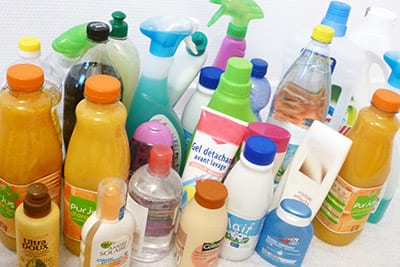Exposure to phenols

Phenol assays during pregnancy and the first year of life in SEPAGES cohort
Urine collected from the SEPAGES cohort revealed exposure to twelve phenols during pregnancy and the first year of the child’s life. Some of the phenols detected are known endocrine disruptors (such as bisphenol A), and all are at least suspected to be endocrine disruptors. Exposure to these substances during the period can affect the health of the fetus. For example, some of these phenols may alter the proper functioning of the thyroid system, which plays an important role in fetal development.
Pollutants measured in this study
Four parabens, five bisphenols (A, S, F, B, AF) as well as benzophenone-3, triclosan, and triclocarban were detected in the urine of pregnant women (second and third trimesters of pregnancy) and of children (at two and twelve months). Multiple sources can account for the exposure to these pollutants, such as food, cosmetics and care products, or medicine.
To what were the SEPAGES volunteers exposed?
Despite regulations to limit the use by manufacturers of some of these phenols, they remain present in the urine of SEPAGES volunteers. Parabens, triclosan, and bisphenol A were detected in more than 80% of the urine samples despite the severe restriction of the use of parabens and triclosan by the French and European authorities in 2009 and 2014. Bisphenol A was banned from food packaging, bottles, and kitchen utensils in France in 2015. In addition, bisphenol S, an emerging compound used by manufacturers to replace bisphenol A, was found in about a quarter of the urine samples collected during pregnancy and at two months, whereas it was detected in 78% of samples collected at one year. Only trace amounts of other bisphenols (AF, B, F) were detected (<5%), independent of the time at which the samples were collected.
Are the levels detected in the SEPAGES study different from other studies?
The concentrations of phenols measured in SEPAGES volunteers during pregnancy were lower than those measured in a previous study conducted in Nancy and Poitiers between 2003 and 2006 (EDEN Study). This may be explained not only by the evolution between the two studies of the regulations on the use of certain phenols but also by the fact that the socio-economic level of the participants and of the metropolitan areas involved in each study differed between the two studies. We cannot compare the urinary concentrations detected in the urine samples of SEPAGES children with national levels because the SEPAGES study is the first study in France to provide such data.
What factors influence phenol exposure in the SEPAGES study?
For bisphenols, occupation may be a risk factor for exposure. Previous studies suggested higher urinary levels of bisphenol A in women whose occupation requires handling cashier receipts (cashier, pharmacist, etc.). In the SEPAGES study, women in this category had higher levels of bisphenol S but not of bisphenol A. This suggests that bisphenol A is substituted by bisphenol S in cash receipts. In addition, urinary concentrations of most measured compounds increased with the age of the children. This result may be related to the evolution in behavior between 2 months and 1 year (putting objects in the mouth, etc.) and to the diversification of behavior.
For further:
Matthieu Rolland, Sarah Lyon-Caen, Amrit K Sakhi, Isabelle Pin, Azemira Sabaredzovic, Cathrine Thomsen, Rémy Slama, Claire Philippat, SEPAGES study group – «Exposure to Phenols During Pregnancy and the First Year of Life in a New Type of Couple-Child Cohort Relying on Repeated Urine Biospecimens». Environ Int, 2020 June.
Read the article